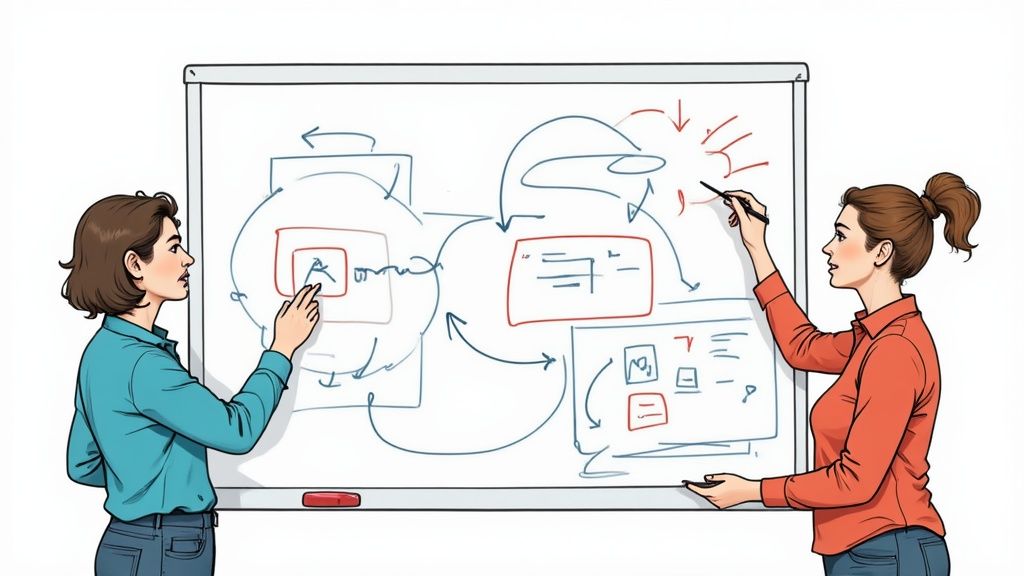10 Proven Team Communication Strategies That Drive High-Performance Results

Understanding the Real Impact of Strategic Team Communication
Good team communication forms the heart of successful teams. When team members share information openly and listen to each other, it creates an environment where everyone can contribute their best work. The impact extends beyond just conversations – it shapes how teams tackle challenges, make decisions, and achieve results together.
The Link Between Communication and Measurable Outcomes
Clear communication leads directly to better business results. Teams that communicate well complete projects faster, make fewer mistakes, and get more done. For example, when everyone understands their role and timeline clearly, they avoid wasting time on duplicate work or missing deadlines. Regular check-ins also help catch potential issues early before they become bigger problems.
Good communication also builds trust between team members. When people feel comfortable sharing ideas and giving feedback, they collaborate better and help each other succeed. This supportive environment helps teams adapt to changes and take on ambitious goals with confidence.
The Power of Transparency and Open Dialogue
When team members can share thoughts openly without fear of judgment, they contribute more fully to the team's success. Clear communication prevents misunderstandings that could derail projects and hurt team morale. Research shows that effective communication can boost team productivity by 20-25%, largely due to increased trust and better non-verbal communication. Additionally, 97% of workers say workplace communication directly affects their daily work. Read more communication statistics.
Fostering Psychological Safety within Teams
Beyond just sharing information, strategic communication creates psychological safety – where team members feel they can speak up without facing negative consequences. This safety allows people to take appropriate risks, be vulnerable, and learn from mistakes. Think of a sports team – players who fear making mistakes play too cautiously and miss scoring opportunities. Similarly, team members who fear speaking up miss chances to solve problems.
By making strategic communication a priority, organizations help their teams reach their full potential. This requires both implementing effective communication tools and building a culture where open dialogue and psychological safety can thrive.
Breaking Through Communication Barriers That Hold Teams Back

Clear team communication is vital for success, but several barriers can get in the way. From basic misunderstandings to complex cultural differences, these obstacles need to be identified and addressed to build a productive team environment. Let's explore how to spot these barriers and develop practical solutions.
Identifying Common Communication Barriers
The first step to better team communication is recognizing what's getting in the way. Here are the key barriers teams often face:
- Unclear Messages: When information is vague or poorly explained, it leads to confusion. This happens especially in written messages where you can't see facial expressions or hear tone of voice.
- Too Much Information: Teams today deal with endless emails, chats, and updates. Important messages get buried in the noise, making it hard to focus on what matters.
- Cultural Differences: Team members from different backgrounds may have different communication styles. This can create unintended misunderstandings about meaning and intent.
- Low Trust: Without trust, people hold back their ideas and avoid giving honest feedback. This hurts teamwork and makes it harder to solve problems together.
- Physical Distance: Remote teams and different time zones make real-time communication challenging. Even office layouts can discourage natural interaction between team members.
Research shows these barriers have real impact – 86% of employees say poor communication directly causes workplace failures, conflicts and lower productivity. Learn more about communication stats at Becoming Your Best.
Practical Ways to Overcome Barriers
After identifying barriers, here's how teams can work to overcome them:
- Focus on Clear Language: Use simple, direct words and give specific examples. Skip unnecessary jargon that might confuse people.
- Create Communication Rules: Set up clear channels for different types of messages. Use project tools to keep information organized and easy to find.
- Welcome Different Styles: Build a team culture that respects diverse ways of communicating. Provide guidelines that help everyone understand each other better.
- Build Team Trust: Make space for open discussions where people feel safe sharing their thoughts without judgment.
- Use Tools Wisely: Pick the right mix of video calls, chat, and collaboration software to help remote teams work together smoothly.
Taking active steps to address these barriers helps teams communicate better, work together more effectively, and create a more positive workplace where everyone can succeed.
Mastering Multi-Channel Communication Strategy

Smart communication beats more communication every time. The key is picking the right channels for different messages to create an environment where everyone stays informed and gets things done. Each communication method has its unique advantages – the trick is knowing when to use which one.
Choosing the Right Channel for the Right Message
Think of communication channels like tools in a toolbox – you wouldn't use a screwdriver for every job. Email works great for detailed updates, chat apps handle quick questions, and video calls or in-person meetings are perfect for deep discussions and brainstorming. The secret is matching the message to the medium.
When deciding which channel to use, consider two main factors: how urgent is it, and how sensitive is the information? Time-critical updates need instant delivery methods, while confidential matters require secure platforms. Having clear guidelines about which channels to use when helps everyone stay on the same page.
Building an Integrated Communication Ecosystem
Success isn't just about having multiple channels – it's about making them work together smoothly. Set clear rules about what goes where. For example, project updates belong in the project management tool, while quick questions go to chat. Recent data shows that while 92% of companies use email with 89% effectiveness, in-person events used by 78% of companies achieve 97% effectiveness. Learn more about these stats at flair.hr.
Managing information overload is crucial too. Your team needs to filter out noise and focus on what matters. The right mix of channels helps keep important messages from getting buried.
Maintaining Consistent Messaging Across Platforms
Keeping messages consistent across different channels can be tricky. A central information hub like a project management system or company wiki helps ensure everyone accesses the same accurate information, regardless of how they receive it.
This approach means team members get the same core message whether they check email, chat, or the project platform. When messaging stays consistent, it builds team identity and keeps everyone aligned. The result? Clear communication that drives projects forward and strengthens team connections.
Creating a Culture of Authentic Open Communication
Open and honest communication forms the foundation of every successful workplace. When team members feel comfortable sharing ideas freely, it leads to better solutions, stronger relationships, and improved results.
The Importance of Psychological Safety
Psychological safety is essential for open communication to thrive. Team members need to know they can speak up without facing negative consequences. A good example is when a junior team member feels confident enough to point out a potential issue that senior staff missed. Without psychological safety, valuable perspectives often go unspoken, which can hurt the team's performance.
Practical Techniques for Fostering Trust
Building trust requires ongoing effort and commitment. Support teams can encourage both positive and constructive feedback to show team members their input matters. Clear communication guidelines help prevent confusion – like setting expectations for response times and choosing the right channels for different types of messages.
Encouraging Constructive Feedback and Open Dialogue
Feedback should flow in both directions. Team members need regular opportunities to give and receive honest input in a supportive way. One-on-one meetings provide dedicated time for these important conversations. Leaders must model openness by communicating transparently themselves.
Developing Leadership Communication Styles that Inspire Openness
Leaders play a key role in building an open communication culture. Effective leaders actively listen, consider different viewpoints, and explain the reasoning behind decisions. When team members understand why choices are made, they feel more valued and engaged. This environment of trust and transparency helps teams reach their full potential.
Using Technology to Connect Teams Better

Smart use of technology can help teams work together more smoothly. But just buying new tools isn't enough – you need to pick the right ones that match how your team actually works.
Choosing Tools That Fit Your Team
Each team communicates differently. A sales team on the road needs mobile apps they can use anywhere. Development teams focus more on project tracking and group collaboration. Think about your team's daily workflow and pain points before picking new tools. For example, if your team feels overwhelmed by too many messages, look for tools that organize communications in one place.
Making New Tools Work Smoothly
Adding new technology can disrupt work if not done carefully. Start with a clear plan to roll things out. Train everyone thoroughly and provide ongoing help. Connect new tools with your existing systems to keep things simple. For instance, if you add Supportman customer feedback into Slack, teams can easily see feedback right where they already chat.
Looking at What's Working
How do you know if your tech investments help? Watch key numbers like response times, message clarity, and team engagement. With project tools, track task completion speed and how often miscommunications happen. Using data helps spot areas to improve and shows the real value of good tech choices.
Building Your Communication Tools
A strong communication system should connect different tools into one smooth workflow. This might mean chat for quick questions, video calls for meetings, and project tools for teamwork. But be careful not to use too many tools – that just creates confusion. Pick tools that work well together and match your team's style. For example, pairing Supportman with Slack lets service teams discuss customer ratings right in their main chat app, making feedback discussions more efficient.
Measuring and Optimizing Communication Success

To succeed over time, team communication needs ongoing evaluation and fine-tuning. Like tending a garden, teams must regularly assess and nurture their communication practices to drive better results. Let's explore how to measure and improve team communication.
Establishing Meaningful Metrics
Before improving team communication, you need clear metrics to track progress. Focus on measurements that directly show how well your team communicates:
- Project Completion Rates: Track if projects finish on time and within budget. Communication issues often lead to delays and cost overruns.
- Misunderstanding Frequency: Monitor how often team members need clarification. This highlights where initial communication falls short.
- Team Satisfaction: Use quick surveys to see how team members feel about group communication. Do they believe their input matters?
These metrics give you solid data on what's working and what needs work. Let the numbers guide your improvements.
Gathering Actionable Feedback
While metrics tell part of the story, qualitative feedback adds essential context. Regular one-on-one and team feedback sessions help uncover communication dynamics that numbers alone miss. A team might hit all their deadlines but struggle with impersonal or dismissive communication styles.
Create a safe space for honest input during feedback sessions. This builds a culture of improvement and helps team members feel heard. Tools like Supportman can help collect and analyze feedback efficiently through Slack integration.
Implementing Changes and Iterating
Once you spot areas for improvement, turn that feedback into concrete changes. This could mean trying new communication channels, adding tools, or updating communication guidelines. For example, if written messages cause confusion, add more visuals or quick check-in calls.
The key is making small changes and measuring results. No communication approach is perfect from day one. Keep reviewing metrics, gathering input, and adjusting your methods. This creates steady improvement as your team grows and changes.
Drive Team Success With Supportman
Want to improve your team's communication and customer support? Supportman helps collect real-time customer feedback and discuss it in Slack, creating a culture of constant improvement. Try it free today – no credit card needed!
What to do next
Whenever you're ready, here's three ways we can help you scale your support org:
- Claim your free Support Manager Handbook. It's a free 30+ page guide filled with strategies, tactics, and best practices for scaling your support org. Download it here.
- Subscribe to our Support Ops newsletter to get the latest updates here.
- Set up Internal Documentation with Tettra to start automatically answering the questions you get in Slack. Here's how.

